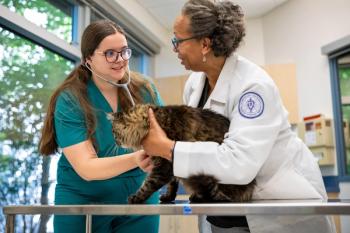
CVC Highlight: My approach to canine dystocia
Unlike many veterinarians, I breed dogs, so I have experience in breeding and whelping puppies.
Unlike many veterinarians, I breed dogs, so I have experience in breeding and whelping puppies. I probably take a different approach to breeders and discussing their concerns about dystocia because of my experience and encourage you to do so as well. Try to keep in mind that breeders are experienced and usually knowledgeable; in fact, they may have whelped hundreds of litters. So approach them with respect.
PREWHELPING POINTERS
It's important to know the bitch's expected whelping date. Ninety-nine percent of dogs whelp 63 days after ovulation (the day the serum progesterone concentration increases above 5 ng/dl as determined by a quantitative assay). You can determine the ovulation date by using vaginal cytology to identify the first day of diestrus, which occurs six days after ovulation, and the owner can use this information to prepare for whelping or an elective cesarean section. With an elective cesarean section, the whelping date is crucial. You don't want to deliver the puppies too early; even one or two days early can be problematic.
Abdominal palpation is not a good method for detecting pregnancy unless you're very skilled. You'll feel discrete swellings at gestation days 20 to 25, but at day 30, they'll start to blend together. It's especially difficult to palpate the swellings in a large dog with few pups. You can radiograph the dog at day 45 and later to detect pregnancy. In fact, I recommend radiographing all pregnant dogs at day 50 to 60 so you have an idea of how many puppies to expect. You can generally detect the minimum number, but not the maximum. So it's important not to overinterpret the radiograph (e.g. it's better to tell the breeder "she's carrying at least five puppies").
As the expected whelping date nears, the owner should take the bitch's temperature once or twice daily. A decrease below 99 F (37.2 C) (or a serum progesterone concentration < 3 ng/dl) indicates that the bitch should begin labor within 24 hours.
It is not unusual for a bitch to be extremely uncomfortable the last week of gestation. This should not be confused with actual stage 2 labor, which is characterized by active uterine contraction.
DYSTOCIA AND FETAL DISTRESS DETECTION
Dystocia caused by failure of the uterus to push the fetus into the birth canal can be divided into primary and secondary uterine inertia. Primary inertia is characterized by lack of abdominal press. Secondary inertia follows a period of apparently normal labor that then ceases. This diagnosis is based on the lack of labor without problems involving the birth canal (e.g. no stuck puppies).
Once dystocia occurs, you have a small window of opportunity to save the unborn puppies, so it's important to recognize and address it quickly. You have dystocia when
- No puppy is born within four hours of the temperature readjusting to normal (> 100 F [37.7 C]).
- Active stage 2 labor lasts more than one hour without producing a pup.
- More than three hours pass between pups without active contractions.
- A black, green, or red discharge is present before any pups are born (indicating placental separation and fetal distress), or a large amount of fresh blood is passed during labor.
- A pup is lodged in the birth canal.
To help determine the presence and cause of dystocia and evaluate the bitch's condition, the following procedures are indicated: Assess the bitch's vital signs, do a complete physical examination including abdominal palpation and a digital vaginal exam, and perform laboratory testing (check the packed cell volume and total protein concentration to help identify bleeding, and measure the blood glucose and serum calcium concentrations). I used to give calcium to every bitch with dystocia, but they generally don't need it; calcium deficiency is not a common cause of uterine inertia.
To assess fetal distress, radiographs are helpful. Take a ventrodorsal and a lateral view to assess the fetal number, relative size, and position. Keep in mind that many pups that look too large radiographically can fit through the birth canal. The ventrodorsal view doesn't generally help diagnose dystocia, but it does help identify pelvic trauma and narrowing. You can also use ultrasonography to assess fetal distress by evaluating fetal motion and heart rate. The fetal heart rate should be twice the maternal heart rate (< 150 beats/min is distress; < 100 beats/min is severe distress).
TREATMENT TACTICS
With dystocia, you need to ascertain what clients want and what they can afford. How important are live pups to them? Cesarean section is a tool for producing live pups, and if clients want live pups, you should not delay in doing it. But if they can't afford it, you can try other techniques such as oxytocin and fetal manipulation.
Oxytocin
You have several options for managing dystocia. Oxytocin can be used as the first line of treatment for primary uterine inertia, but most bitches will not respond to it. You will generally have to do a cesarean section to address primary uterine inertia. Secondary inertia without fetal malposition or fetal distress can be hard to sort out. The bitch could be taking a break, but if it's been more than four hours since the birth of the last puppy, it's probably uterine inertia.
If oxytocin administration isn't contraindicated after I've performed a vaginal exam and radiography (e.g. no narrowed birth canal or fetal malpositioning), then I administer up to two doses, 20 minutes apart. I use small doses because it decreases blood flow to the fetus (e.g. 0.5 units for a Chihuahua and 2 to 3 units for a Newfoundland subcutaneously or intramuscularly). The uterus becomes refractory to oxytocin after a few doses, so you need to do a cesarean section for larger litters (or if two doses don't produce contractions and a puppy).
Fetal manipulation
If there is absolute fetal oversize or inadequate pelvic diameter, do a cesarean section. If there is only one large pup in the canal, you can try to manipulate it. If you detect fetal malposition, use gentle manipulation with your fingers around the pup's neck or shoulders (you need long fingers for this). And use lots of lubricant. You may be able to push them from behind by using abdominal palpation or use one finger rectally and one vaginally. Use slow steady traction, and warn anyone in the room that fetal dismemberment could occur despite your care. Above all, don't waste time. Each puppy is valuable to the breeder.
Cesarean section
Cesarean section is indicated if you detect fetal distress on ultrasonography, uterine inertia does not respond to oxytocin, or fetal oversize or malposition or vaginal obstruction exists. If you do a cesarean section, plan ahead. You need to limit the time the bitch spends in dorsal recumbency so she experiences no further decrease in ventilation. And limit the time from anesthetic induction to pup removal. Don't induce anesthesia before you're scrubbed and ready to do surgery. Have all your equipment ready and adequate staffing on hand.
Administer intravenous fluids to the bitch. I give atropine as a premedication to support the maternal and fetal heart rate. For anesthesia, propofol and isoflurane (or sevoflurane) are best. You can also do a line block with bupivacaine. You can give the bitch an opioid once the pups are removed (oxymorphone, hydromorphone, or morphine).
Delivery and postoperative care
Vigorous stimulation and oxygen administration are the best techniques to revive the puppies once they're removed. You can suction the oropharynx to remove fluid, but don't swing the puppies; it can cause brain damage, and you could throw them. If the puppies aren't breathing and the bitch has been given opioids, administer one drop of naloxone and doxapram sublingually. Be patient; you should try to revive them for 15 to 20 minutes before you give up. For postoperative pain, prescribe tramadol for the bitch.
PROSPECTIVE PREGNANCIES
For subsequent pregnancies, a vaginal delivery can be attempted, especially if the problem was due to big pups. In this situation, advise the breeder not to overfeed the bitch so the pups aren't so big. Patients with secondary uterine inertia tend to have it again. And if the bitch experienced primary uterine inertia, she'll most likely need a cesarean section for subsequent deliveries.
Scott Shaw, DVM, DACVECC
Department of Clinical Sciences
Cummings School of Veterinary Medicine
Tufts University
North Grafton, MA 01536
Newsletter
From exam room tips to practice management insights, get trusted veterinary news delivered straight to your inbox—subscribe to dvm360.





